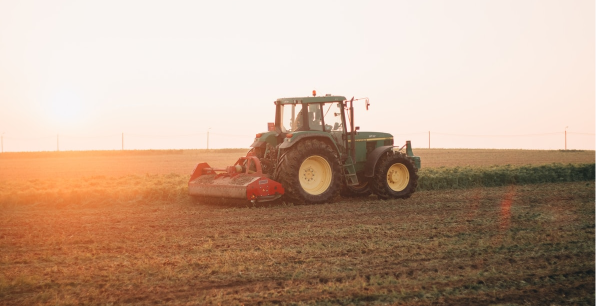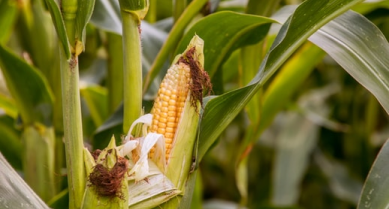Seasonal Climate Forecasts for Agriculture
Executive Summary
Agrimetrics have investigated the agricultural applications of a long term weather prediction called Seasonal Climate Forecasting, provided by the firm Weather Logistics.
These forecasts were used to inform whether a grower should have sown a winter crop in 2018 and 2019, in one of 20 locations throughout the UK. Winter cereals develop their tolerance to cold over time in a process called hardening; during this time, newly sown crops can be killed or damaged by freezing temperatures. Therefore, crops should ideally be sown preceding a period of relatively mild conditions to ensure a) their survival and b) a worthwhile yield.
We concluded that Seasonal Forecasts have reached a level of accuracy whereby they could provide effective guidance for growers in this scenario. However, working with these forecasts is not straightforward – they will need to be transformed into a more usable format before their value can be realised by farm decision makers.
Can Seasonal Forecasts inform planting decisions?
The rain was relentless in England in Autumn 2019. The UK Met office reported that for much of the country rainfall totals were higher than average. We heard many farmers comment that not only was this making harvesting difficult, but it was also preventing the sowing of winter crops. Some farmers started talking about giving up on planting winter crops entirely and waiting until spring.
Winter cereals have been bred to tolerate cold conditions, but they need to build up their tolerance over time, a process called hardening. A lack of time for initial growth and then hardening can mean that newly sown crops get killed or damaged by freezing temperatures. So what should a farmer have done if a window of opportunity did open up where the soil was dry enough to sow: plant and risk frost damage or not plant and leave the field, hoping that weather conditions in the spring would be better? Isn’t this where a weather forecast could help?
What to do if a planting window is missed?

Severe flooding in 2019 delayed the sowing of many winter crops in the UK
Hypothetically speaking, an accurate forecast of daily weather weeks to months ahead could certainly be used to inform the farmer’s decisions. For example, a farmer could go ahead and sow if the forecast predicted no severely cold temperatures at all. Conversely, if the forecast predicted constant frost then the farmer would be unlikely to be able to plant at all. Alternatively, a mild spell could be followed by a gradual adjustment to cold so that the crop is hardened before any severe cold weather. If however, there is a sudden transition to severe cold, the crop may have established itself but not hardened and there is a risk of it being killed.
As you may know, weather forecasting is improving! Most people know of the short-term weather forecasts which, for the UK, town or city-level weather summaries are now considered accurate up to a week ahead. These are referred to as deterministic forecasts, since they tell us what weather to expect with confidence. The trouble with these is that we cannot predict specific day-to-day weather with certainty far enough into the future to inform a farmer about which of the above winter scenarios are most likely.
A relatively new and improving area has been seasonal climate forecasting, providing regional outlooks from several weeks to several months into the future. These models are designed to represent the general circulation patterns and large-scale climate processes and are presented as different weather futures, known collectively as an ensemble weather prediction. When delivered close to a field location, and when trained to represent seasonal variability, these can inform a farmer of how likely a crop will be exposed to adverse weather conditions during its development.
It has only been in recent years that seasonal climate forecasts have really been able to prove that they can be useful for crop decisions. Reliable seasonal forecasts can for instance inform through hedging decisions in the field i.e. they should provide an accurate likelihood estimate that a crop will either survive or fail. They can also provide vital information about the daily weather variability, since this is intrinsically linked to cold weather risk and often independent of the overall accuracy of the forecast.
The question is, could seasonal climate forecasts be both accurate and reliable enough to fundamentally influence a grower’s decision about whether to sow a winter crop? This was the question we were asking at Agrimetrics in the late autumn.
Testing the reliability of seasonal forecasts for growers
We were prompted into running an investigation by Dr. Chris Nankervis – Founder and CTO at Weather Logistics, who specialise in seasonal climate forecasting; offering reliable daily weather outlooks to within a near field-level resolution. Their company vision is to integrate their weather data into pre-existing decision-support tools used by growers, producers and agronomists to reduce food waste, maintain soil health, and bolster the sustainability of the agricultural industry. We were impressed by their reported improvements in forecast accuracy for temperatures in the winter months, even when forecasted 1 month, 2 months or 3 months into the future. We discussed this with Chris and decided to run an experiment.

Fig. 1: Forecasted and actual frequency of days for which the minimum temperature fell below -2°C. Forecasts are seasonal forecasts from 5 providers for the 2018/2019 winter (a, b and c) and the 2019/2020 winter (d, e and f) when forecast 1 month (a, d), 2 months (b, e) and 3 months (c, f) prior to the forecasted month. Seasonal forecasts came from 5 providers: Weather Logistics; The National Centers for Environmental Prediction (NCEP), The European Centre for Medium-range Weather Forecasting; the UK Met Office and Météo-France. The black bars marked “TRUTH” are what was observed. Data citations are at the foot of this post.
We asked the question: if a farmer in September or October was contemplating sowing a winter cereal crop, should a seasonal forecast influence their decision to sow? We chose 20 sites from throughout the UK with contrasting climates and obtained seasonal weather forecasts from several providers for those sites for November to May for recent years. We won’t show all our results here, the full data can be obtained from Agrimetrics, but instead we’ll just show you the results for a single site located near Kings Lynn in Eastern UK (north of Cambridge).
The most striking results were when we looked at the predicted probabilities of experiencing a day with temperature below a threshold – a measure of the intensity of cold days in each month. We chose -2°C as a below freezing temperature that would kill or damage a crop that had not been hardened (we call these “Cold days”). See Fig. 1 below for details.
Results

Initial findings suggest that Seasonal Weather Forecasts can help growers decide when to drill
So what do we see? The major difference is in the forecasted probability of cold days between the 2018/2019 winter and the 2019/2020 winter, with a cold winter being far more likely in 2018/2019 winter. In general we see a contrast in the winter months of around 1 day in 5 or 6 being cold to around 1 day in 20. There is also clear association between these predicted probabilities and what was seen in the data, although we need more data and analysis to really characterise the forecast accuracy.
What does all this mean for our agricultural decision scenario? The results suggest that faced with the option to plant a winter crop in October/November a farmer in 2018 would see that cold days were predicted to be relatively frequent in 2018/2019 but predicted to be less frequent in 2019/2020. Moreover, the actual number of days where the temperature is below 2 degrees Celsius is lower in 2019/20 so the forecasts have provided good intelligence to the farmer.
Would a farmer in early October 2019 make a different decision if they saw the forecast for 2019/2020 compared to if they saw what we saw for 2018/2019 (but applied to 2019/2020)? They would probably want to know more details, such as the amount of hardening time experienced in the autumn and winter months too – these appear far more similar between the years. So the answer is possibly “yes” – given that both years would have experienced similar hardening extents, the lack of hard frosts this year would have made it more likely that a winter sown crop would have built sufficient cold tolerance to tolerate any infrequent cold days. Whereas if they’d experienced the same level of cold days seen in the 2018/2019 winter then perhaps it would be unwise to sow a winter crop.
The future of Seasonal Forecasts for Ag
This is conjecture at this stage and we’re keen to get to the bottom of the important details in real farming scenarios to understand where the relevance could be. If you have relevant details to share, then please get in touch and let us know. For now, the conclusion is that seasonal forecasts do indeed seem to be approaching accuracy and precision levels to inform decision making in agriculture although there is still plenty room for improvement. Now, working with these seasonal forecasts is not easy: it takes some skill and training to be able to obtain and work with the forecasts in the right way to generate the correct results. That’s where both Agrimetrics and Weather Logistics come in – with Weather Logistics specialising in generating the farm-relevant forecasts and Agrimetrics keen to support getting those data into the most useable format for decision makers. We’re looking forward to revealing more actionable insights from seasonal forecasts and enabling access to seasonal forecast information through our platform in future. Don’t hesitate to send us requests.
What to know more about long term Seasonal Climate Forecasting?
Contact usFind out more about this data
Data Citations
NCEP, ECMWF, Météo-France and Met Office seasonal climate projections were Generated using the Copernicus Climate Change Service information 2020.
Weather Logistics data Contains modified Copernicus Climate Change Service information 2020.
Neither the European Commission nor ECMWF is responsible for any use that may be made of the Copernicus information or data it contains https://cds.climate.copernicus.eu/api/v2/terms/static/licence-to-use-copernicus-products.pdf
Historical observation data came from the HadUK Gridded climate observation dataset https://www.metoffice.gov.uk/research/climate/maps-and-data/data/haduk-grid/datasets and Darksky.net observations (Powered by DarkSky).
About Agrimetrics
Agrimetrics is the food and farming sector’s Data Marketplace. We enable organisations to safely share and monetise their data, whilst making it easier for data-consumers to access the information they need. Our goal is to help create a more productive and sustainable food system by enabling next-generation solutions as quickly and affordably as possible.
We are one of four centres for agricultural innovation founded with an initial investment from Innovate UK. Our founding partners are NIAB, SRUC, Rothamsted Research and The University of Reading. We have strategic partnerships with Airbus and Microsoft and are a participant in Microsoft’s prestigious AI for Earth programme.
Other articles that might interest you

AI identifies crops from space with 90% accuracy
Agrimetrics launches CropLens AI, a proprietary algorithm that identifies crop types from space.

ClearSky: Cloud free satellite data for agriculture
ClearSky's artificial intelligence removes a major barrier to the efficacy of satellite

ClearSky: Cloud free satellite data for agriculture
ClearSky's artificial intelligence removes a major barrier to the efficacy of satellite

Agrimetrics partners with Airbus to reduce cost
Crop Analytics, a crop and field analytics package from Airbus, is now available at a new, lower price.



